Logistics in the humanitarian context (Syrian crisis as a case study)
Автор: Wael Alasfar
Журнал: Экономика и социум @ekonomika-socium
Рубрика: Основной раздел
Статья в выпуске: 10 (89), 2021 года.
Бесплатный доступ
The purpose of this paper is to discuss the concept of logistics in the humanitarian context, and to point out to the differences between humanitarian logistics and commercial logistics. Based on the lessons learnt during the humanitarian crisis in Syria, which was the reason that made it the destination for a huge number of the international non-governmental organizations along with UN agencies, this paper will point out to the differences between humanitarian logistics and commercial logistics.
Logistics, humanitarian logistics, commercial logistics.
Короткий адрес: https://sciup.org/140260794
IDR: 140260794
Список литературы Logistics in the humanitarian context (Syrian crisis as a case study)
- Abidi, de Leeuw, Klumpp. (2014). Humanitarian Supply Chain Performance Management: A Systematic Literature Review. Amsterdam Business Research Institute. p.17.
- Barton, N. I. M. (2000). Logistic Support to Humanitarian Aid operations: Logistic Solutions to Food Security. MSc Defence Logistics Management No. 2 Dissertation, Cranfield University. RMCS. Shrivenham. p.39.
- Baumgartner, Blome. (2014). Supply chain integration capabilities. Green design strategy and performance: A comparative study in the auto industry. p.53.
- Chandes, Paché. (2010). Investigating Humanitarian Logistics Issues: From Operations Management to Strategic Action. Journal of Manufacturing Technology Management. p.33.
- Chang, Wilkinson, Potangaroa, Seville. (2012). Resourcing For Post-Disaster Reconstruction: A Comparative Study of Indonesia and China. p.67.
- Fawcett, Tom. (2013). Data Science and its Relationship to Big Data and Data-Driven Decision Making. p.24.
- International Federation of the Red Cross (IFRC) (2020). “World Disasters Report” International Federation of the Red Cross and Red Crescent Societies. Geneva.
- Kovács, Spens. (2007). Humanitarian logistics in disaster relief operations, International Journal of Physical Distribution & Logistics Management. Volume 37. Issue 2. p.66.
- Kovács, Spens. (2009). Identifying challenges in humanitarian logistics. International Journal of Physical Distribution & Logistics Management. Volume 39. Issue 6. p.44.
- Lambert, DM; Stock, JR & Ellram, LM. (1998). Fundamentals of Logistics Management. Boston: McGraw-Hill International Editions.
- Langley, Rutner. (2000). Logistics Value: Definition, Process and Measurement. The International Journal of Logistics Management. Volume 11. Issue 2. p.45.
- Moore, D and Antill, P. (2000). ‘Humanitarian Logistics: An Examination of and Military Involvement In, The Supply Chain for Disaster Relief Operations’ in Global Logistics for the New Millennium, Proceedings of the ISL 2000 Conference. July. Iwate. Japan. p.51 – 57.
- Oloruntoba, R. and Gray, R. (2002). Logistics for humanitarian aid: A survey of aid organizations” in Griffiths. J. Hewitt, F. and Ireland, P. (Eds). Conference Proceedings of the Logistics Research Network, Institute of Logistics and Transport. Birmingham.
- Scholten, Sharkey, Fynes. (2010). Leagility in humanitarian aid (NGO) supply chains. International Journal of Physical Distribution & Logistics Management. Volume 40. Issue 8. p.38.
- Thomas, Mizushima. (2005). Humanitarian supply chains and performance measurement schemes in practice. International Journal of Productivity and Performance Management. Volume 64. Issue 6. p.57.
- Whiting & Ayala-Öström. (2009). Advocacy to promote logistics in humanitarian aid. p.51.


